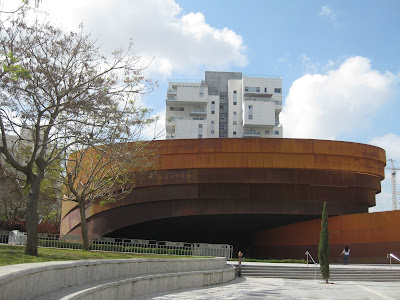To understand what this exhibition is about, one has to come with some prior knowledge of the basic background, otherwise all one sees is three dark spaces (galleries) with a bunch of personal clothes& accessories, and noisy sound from video screens placed all around.
clothes (upper gallery)
The exhibition is dedicated to movie actress and filmaker, Ronit Elkabetz (its full name is "Je t'aime, Ronit Elkabetz).
She was born in Israel, the daughter of moroccan immigrants from Mogador (Morocco); achieved her fame as movie actress both in Israel and in France, died untimely leaving two 4-year old twins, and a husband (a well-known israeli architect).
on famous magazine covers (at the entrance of lower gallery)
photos of R.E. at various ages (lower gallery)
more photos of the actress (lower gallery)
Her personality was a combination and a dialogue of East (moroccan roots) and West (french culture), Periferie (born in israeli desert town Beer-Sheba, childhood and adolescence in northern small town Kiryat Yam) and Center (Tel Aviv, Paris, ), Fashion ( model, in the beginning) and Movie making.
The exhibition, so we're told, started with a research of her wardrobe.Her clothes and accessories collected over four decades were donated to the museum by her husband , her parents, and the rest of the family.
video screen and outfits (upper gallery)
As mentioned in the catalogue of the exhibition, behind every item there was a story or memory of some kind, and the item was accompanied by a little written note on that. She believed garments had a soul and showed respect to them by way of wearing and folding them with care and love. Clothes were for her a tool and a language for self-expression.
necklace (intermediate gallery)
shoes (intermediate gallery)
yellow, phantasy dress (lower gallery)
black, long gown (lower gallery)
She had dramatic looks: black hair, pale skin, dark eyes, and she often wore black outfits; some of her roles in the movies she played ,also had a certain dark aura about them (she always reminded me of Maria Calas, the greek, dramatic opera singer). And now, the dark spaces at the exhibition - perhaps signifying a state of mourning and loss for her untimely departure.
black, elegant dresses (upper gallery)
white outfit with dots (upper gallery)
coats (upper gallery)
mirror reflection (upper gallery)
The screens along the gallery displayed fragments from her movies, and from attendance at various cultural events.
video screen, one of many.
As a graduate of the fashion section in her high scool - fashion making, was her dream, but Fate wanted something else for her. She became an actress by chance. And then she tried directing and screen writing and was quite successful (she won prizes and awards).
It was probably all too good to be true...and she left the scene, her family, this world at only 52 years of age following a battle with cancer. RIP ,Ronit Elkabetz!





















































